Preface
Twitter is a social media platform that I’ve never ventured on, and therefore this assignment was already a challenge to approach! As I was searching up previous examples of Twittering Theory Tasks, I stumbled across this blog of a previous student, in which they did their assignment on Jennifer Gonzalez, “a former middle school language arts teacher that helps pre-service teachers build their practice” and also, the host of the podcast “The Cult of Pedagogy”.
In one of the podcast episodes, Jennifer Gonzalez interviews Shane Safir and Jamilia Dugan, co-authors of the book Street Data: A Next-Generation Model for Equity, Pedagogy and School Transformation.
Their approach to school improvement moves away from quantitative data of grades, test scores, attendance and focuses on data analysis on qualitative data of collecting stories, artifacts and observations from the student body, from the ground up — hence “street data”. In this book, she advocates for reinventing schools and organizations into places for equitable learning.
At A Glance – Overview of Twitter Platform
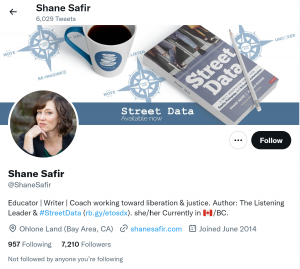
Shane Safir is an educator and writer currently based in British Columbia. She has extensive experience as coach and facilitator working in public education for over 20 years, with focus on creating spaces for educational equity. She is the co-founding principle of June Jordan School for Equity (JJSE) supporting the success of low-income students of color.
Browsing briefly through her followers and following, most of them are also educators from all levels, with majority of them K-12 teachers based in the USA and Canada.
Through this Twittering Task, I have categorized her tweets/retweets as below, as I reflect on the affordances and limitations that Twitter as a platform can provide in context of her engagement and interaction with other educators that she follows, and those who are following her.
Original content – personal
From her original tweets, I was able to piece together some of the important concepts and ideas mentioned in her book, without having read it in its own entirety. Due to the limitation of Twitter’s word count per tweet, her lists that she’s made makes it easy to understand, but at the same time, some extra elaboration is needed to understand its relevance in context.
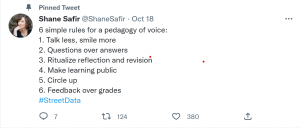
Above is one of the first tweets on her profile.
The “Pinned Tweet” indicates that this post is of high relevance and importance to her own pedagogical values as an educator, in which I assume is an important concept in her book.
The title “6 simple rules for a pedagogy of voice” is a bit unclear to me of what “voice” entails. For those who know of her work personally, or are experienced educators, this information might be apparent.
However, I am not an experienced educator myself, so I had to search it up for more context. I was able to find this article that Shane wrote, in which she goes elaborates on her “pedagogy of student voice” and how each of the points are relevant to fostering ways educators can shift classroom frameworks away from that of compliance to one that uplift students’ voices. This shift in mindset is important to create a safe, warm, and welcoming learning environment to cultivate student agency so that they can be more engaged in their own learning.

Not only does she post contents as an “educator”, she also posts content as a “parent”. This multi-faceted perspective of what she deems important from her different identities makes her values in education seem more down-to-earth and familiar, in which her pedagogy is rooted in practice and concern on a personal level as well.
Original Content – Community
Shane engages on Twitter in a personal level as illustrated above, and also actively at a community level as well. She can be seen retweeting threads and posts from others that align with her values and ideas when it comes to education. This information can be very helpful as a starting point for other educators with similar values to connect and create a broader network of those interested in reformation of school organizations, which is crucial for creating community and pushing for change in a tangible way.
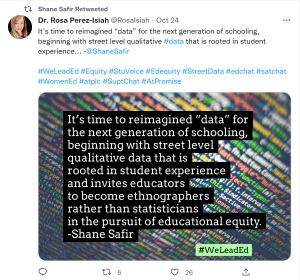
In this retweet of someone else’s post, I was able to see what other educators found impactful, and what they resonated with through Shane’s content (e.g. book, podcast, talks, interviews, etc.) or how that has affected them in return when it comes to their own pedagogical approaches.
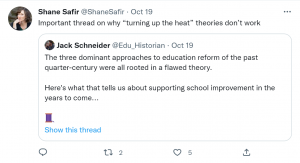
In this thread that she reposted, Shane re-affirms the importance of why “turning up the heat” theories don’t work. I followed the thread and learned that “turning up the heat” means “the racheting-up of pressure” through test-based accountability, teacher evaluations and generally creating an environment of competition.
Paired with some background knowledge of her book content, one can understand how this Twitter thread aligns with her approach to collecting street data, furthermore acting as an “endorsement” of such pedagogical practices.
Promotional Content
Shane uses Twitter as a promotional platform for other forms of media, specifically for her podcast Street Data Pod, in which she invites speakers for discussion and interviews about various aspects surrounding education. This approach to creating conversation reflects her strong beliefs of the need and importance of collecting qualitative data from educators to inform educational practices.
In her interviews, one can also see that she invites many educators of color to talk about equity, and anti-racist practices. By centering their voices and experiences, it is clear that “practicing what she preaches” is at the core and forefront of her pedagogical values.
Twitter is not the greatest place for in-depth and nuanced back-and-forth engagement, especially when a lot of Shane’s career as a coach and facilitator is a role that promotes communication and conversation with others. I can see why she would outsource her preferred method of audio, verbal and written engagement to other platforms.
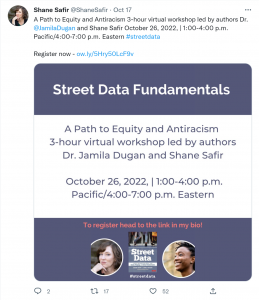
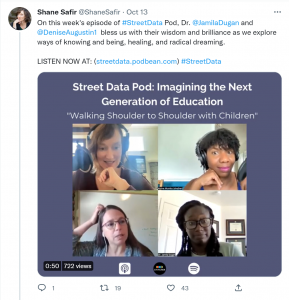
Here she is seen advertising her workshop with her co-author on Twitter with an infographic, as it is easier to catch one’s attention with an image than it is with plain text.
Curious whether she is on other platforms that prioritize images, I did a quick search and found her Instagram. She has two Instagram profiles, one where she shares her personal life through photos of family and friends; and the other for her professional life through sharing promotional infographics of her podcast and workshops.
Through her social media use patterns, it is apparent that the limitations of text on Twitter and images on Instagram makes it difficult to use them as the main platforms for engaging deeply with her writings. However, Twitter is a great place to create community (arguably more so that Instagram), and a very effective way to expand her network and spread what she does professionally.
Shane has her own personal website, acting as a portfolio and main place in which she posts all of her professional work. Her Street Data Podcast can be found on Apple Podcasts, Podbean App, and Spotify.








